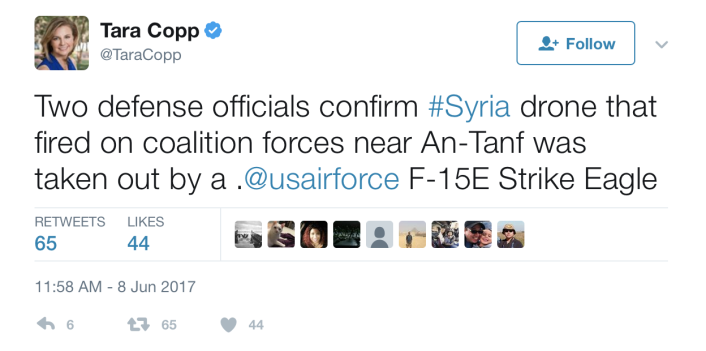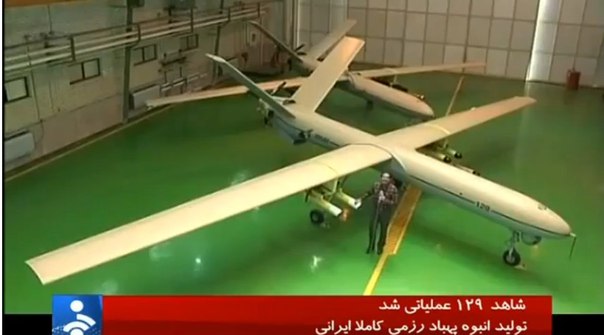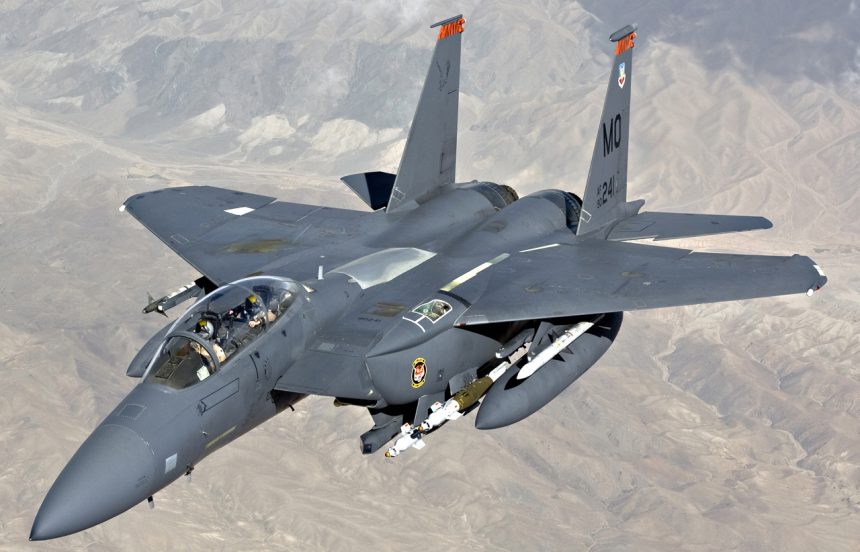Syrian Drone Destroyed by Strike Eagle After It Engaged Anti-Assad Coalition Ground Forces. Second air-to-air kill for the Strike Eagle since Gulf War.
U.S. Special Operations advisors leading anti-Assad Syrian forces came under fire from an Iranian built Shahed 129 drone operated by Syrian pro-government forces on Thursday according to the U.S. Army.
A U.S. Air Force F-15E Strike Eagle shot the drone down.
The incident occurred outside Al-Tanf, southern Syria close to the Jordanian border. An installation in Al –Tanf serves as a forward operating base for British and U.S. special operations teams assisting the anti-ISIL Syrian guerilla group Maghawir al-Thawra or “Commandos of the Revolution”. Maghawir al-Thawra is regarded as an indigenous special operations group who have received training and support from coalition forces to fight the Assad regime.
The U.S. reacted to the drone attack by tasking an F-15E Strike Eagle to locate and destroy the Syrian drone. It was officially the first time U.S. forces had come under air attack by a hostile nation in nearly 20 years and the second air-to-air kill for the Strike Eagle since the downing of an Iraqi Gunship helicopter in 1991.
According to U.S. Army Colonel Ryan Dillon, spokesman of the Combined Joint Task Force-Operation Inherent Resolve (CJTF-OIR), the Assad government Syrian drone strike on U.S. advisors and Syrian revolutionary commandos “did not have an effect on coalition forces,”
“The pro-regime UAV, similar in size to the U.S. MQ-1 predator, was shot down by U.S. aircraft after it dropped one of several weapons it was carrying near a position occupied by coalition personnel who are training and advising partner ground forces in the fight against ISIL,” CJTF-OIR’s public affairs office released in a statement. “The shoot down follows an earlier engagement in the day in which Coalition forces destroyed two pro-regime armed technical vehicles that advanced inside the well established de-confliction zone threatening Coalition and partner forces.”

A 34-mile region around Al-Tanf has been declared a “de-confliction zone” by coalition forces for the past several weeks. This buffer was established to safeguard U.S. and British supported anti-Assad forces. Several incidents have taken place recently inside this de-confliction zone that have prompted a U.S. response. On Tuesday, a U.S. Navy F/A-18 Hornet dropped four bombs killing an estimated 10 pro-Assad combatants and destroyed several of their vehicles.
It is also likely the pro-Assad forces controlling the Iranian made Shahed 129 drone were in close proximity to the drone itself at the time it attacked U.S. advised anti-Assad forces. The Shahed 129 can be controlled by satellite guidance from a remote ground station, but this example was almost certainly controlled by a local ground controller with line-of-sight to the Syrian Shahed 129 when it was destroyed by the U.S. F-15E Strike Eagle.
The incident is significant since U.S. ground forces in the region and, in the entire history of the Global War of Terror, have been largely immune from air attacks. The Iranian-made Shahed 129 drone was also employed by Hezbollah in a 2012 operation over Israel. The Israelis downed the Iranian-made, Hezbollah-controlled drone but the incident marked a dangerous escalation in terrorist capabilities.










